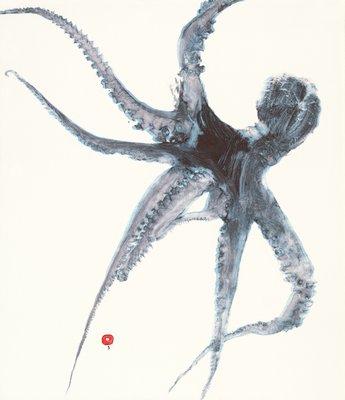
Annie Sessler was struck with inspiration.
Her husband, Jim Goldberg, had just lifted a porgy off a piece of rice paper and what was left was an arresting, inky reproduction of the fish’s form.
As a fisherman frequenting the docks, Mr. Goldberg had noticed another artist practicing gyotaku—the traditional method of Japanese fish printing—where a freshly caught fish is coated with ink and laid on a surface to make an exact impression.
When Mr. Goldberg showed his wife the method, she was sold.
“It was elegant, abstract ... I was shocked. I thought I had married a Japanese master,” Ms. Sessler said during a recent interview inside her Montauk studio. “I ripped the brush out of his hand.”
She created many on her own that night.
Nine years later, Ms. Sessler is still capturing the intricacies of marine life, from squid and octopus to eel and striped bass. And while her husband still brings her the occasional catch, others in the Montauk community have also thrown a fish or two her way.
In her studio hang several striking prints, including a mako shark tail and a sailfish. Ms. Sessler’s passion for capturing the scaly, often slimy, creatures brims over when she talks about the art form.
“It’s like seeing through a microscope. It is easy to get lost in many worlds, in what you thought was just a surface,” she said. “There are passages that you want viewers to traverse. What matters about a fish depends on the artist and the viewer.”
The majority of the species Ms. Sessler uses are from the northeastern Atlantic coast. Some hail from the warm tropical waters of Costa Rica’s Pacific or Tobago’s Caribbean, thanks to the Gulf Stream that brings many exotic species to the East Coast during the warm summer months.
When she is given a fish, she typically soaks it in kosher salt and is careful not to abrase the skin. She selects a paper or fabric, lays the fish down and picks it back up again. Later, she adds her signature mark, which is a simple red stamp with the initial for her last name, “S.”
The negative space is just as important as the print itself, too, she said.
“It’s full and poignant. There’s an energy in the white space,” she said. “The calmness is as exciting as the object. In it, they are both made more alive.”
The artist said her mother, Iza Chateaubriand Sessler, generously donated fabrics she collected in her world travels with her husband, Bruno Robert Sessler, at the beginning of her daughter’s fish-printing endeavor.
“Luscious silks, cottons and others from India, Hong Kong—fabrics thick and sheer, whose names I do not know—got me into an exploration and marriage of all kinds of fabrics,” Ms. Sessler said. “Many old and recycled, with all kinds of fish.”
The 52-year-old artist’s love for fishing dates back her childhood in Port Washington, a little girl on Manhasset Bay with her pole in the water. For a time, Ms. Sessler worked with her father’s business, B. Sessler Company, where she helped import seafood.
She feels connected to and extremely appreciative of the fish she works with, the artist explained. They don’t go to waste. The fish she uses are completely edible, she noted, since the inks are non-toxic and wash right off after she’s done.
As if Ms. Sessler has lived in Montauk for decades—she moved to the East End 11 years ago, falling in love with both the surf and her husband—her work hangs in many local spaces, including The Corner Bar in Sag Harbor, Coastal Home in Bridgehampton and Noah’s restaurant in Greenport.
Given the positive reception her work has received, Ms. Sessler said she is thinking about expanding her prints to other mediums, such as linens, pillowcases and furnishings.
“It’s the process of discovery. Accidents happen, great or bad, they are fun,” she said, explaining that each creation is a different experience. “My head and heart are bursting with ideas.”
For more information, visit eastendfishprints.com.